The Apple iPad Review (2012)
by Vivek Gowri & Anand Lal Shimpi on March 28, 2012 3:14 PM ESTThe Display: In Numbers
Apple is very big on maintaining a consistent experience between its products. We see this a lot in our Mac reviews where it's not unusual to see similar white points across virtually all Apple products. It's no surprise that the with the move to the Retina Display Apple wanted to retain as much of the original iPad's display characteristics as possible. We'll start with an analysis of brightness and contrast, both of which remain relatively unchanged from the iPad 2:
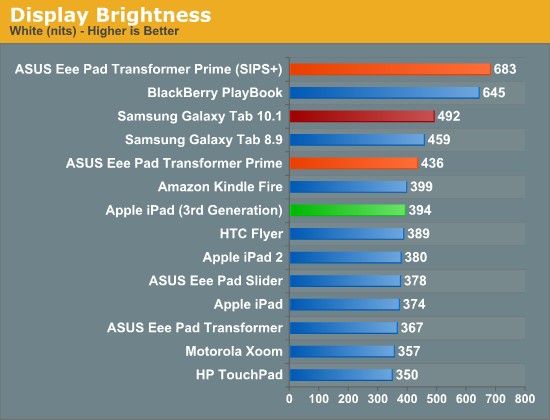
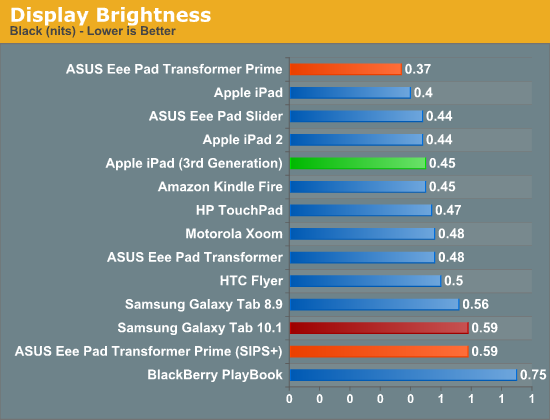
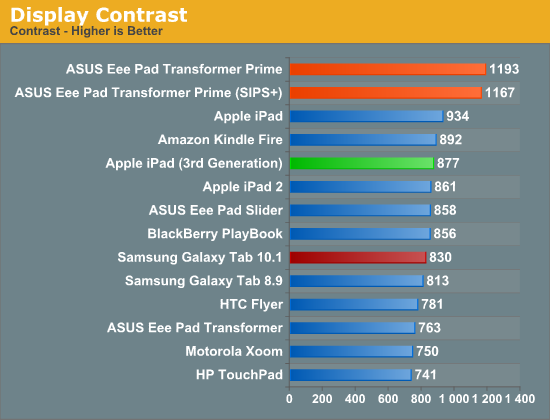
Apple is expected to have triple sourced panels for the new iPad, so you can expect to see variation in these results but for the most part you can expect the new iPad's display to perform similarly to the previous model.
Despite similar brightness and contrast to the previous model, the new iPad offers remarkably better color gamut and color reproduction than its predecessor. Relative to other tablets, the iPad's display is spectacular.
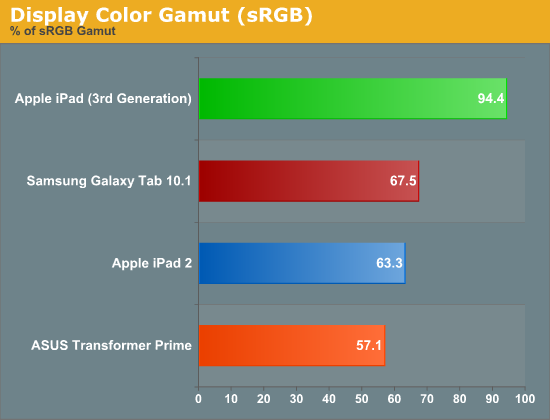
As we mentioned in our Retina Display analysis, Apple delivered on its claims of a 44% increase in color gamut. The new iPad offers nearly full coverage of the sRGB color space and over 60% of the Adobe RGB gamut:
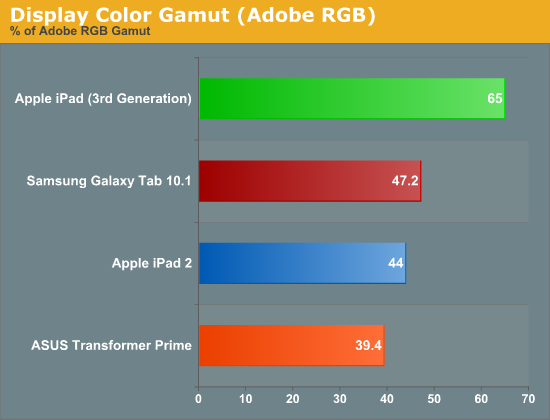
Below is the CIE diagram for the new panel with an sRGB reference plotted on the same chart so you can visualize the data another way:
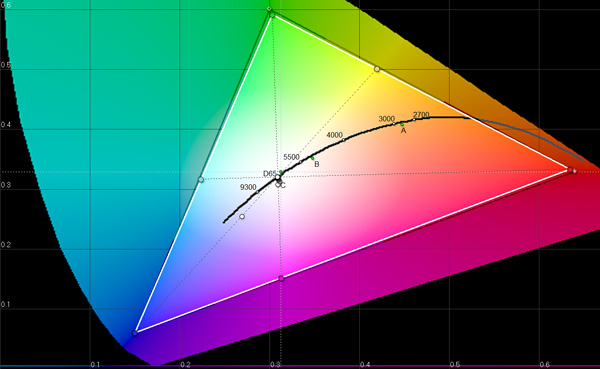
Color accuracy has improved tremendously if we look at delta E values for the primary and secondary colors:
Remember from our display reviews, lower delta E values indicate greater color accuracy. Values below 4 are typically considered good and you can see that the iPad 2 as well as the Transformer Prime both fell short in this department. With the new iPad Apple has clearly focused on color accuracy, which makes sense given it was used as the vehicle to introduce iPhoto for iOS.
Apple still has a lot of work ahead of itself to really put forth a professional quality display in a tablet, but for now the Retina Display is easily the best we've seen in a tablet and a tremendous step forward.
What's most absurd about the iPad's Retina Display is that you're able to get this resolution and panel quality in a $499 device. While we must be careful not to give Apple too much credit here as Samsung, Sharp and its other display partners clearly make the Retina Display, it's obvious that Apple has really been pushing its partners to develop solutions like this.
The biggest problem in the production of any commoditized component is the primary motivation for innovation is to lower cost. For years I argued with notebook PC makers to use higher quality LCD panels but no one was willing to commit to the quantities that would lower costs enough. I was also told that as soon as you put these notebooks on shelves at Best Buy, users wouldn't really care whether they were getting a high quality IPS display or not—all that mattered was the final price.
Apple, under the leadership of Steve Jobs, had a different mentality. Steve's pursuit was quality and experience, cost was a secondary concern. Through slow and steady iteration of this approach, Apple was able to build up a large enough customer base and revenue to be a significant force in the industry when it came to driving costs down. Apple can easily fill your fabs and eat all that you can produce, but you'll have to do whatever it wants to get the order.
Apple's behavior since it got rich has been to drive down the cost of higher quality components, LCDs being a perfect example. Unfortunately other companies don't benefit as much here as Apple tends to buy up all of the production of what it has pushed to create. That's one reason why, although ASUS was first to introduce a 1080p Transformer Pad, it won't launch until well after the new iPad. From what I've heard, the panel makers are all busy servicing Apple's needs—everyone else comes second.
Eventually the entire industry will benefit and all indications point to Apple doing something special for "pro" users in the notebook space next. As I've said previously, Apple has raised the bar with the iPad's Retina Display. The time for average display quality in a $500 tablet is over, the bar has been raised. It remains to be seen whether or not Apple will be able to maintain this quality across all suppliers of its Retina Display. On the iPhone Apple has been entirely too lax about maintaining consistency between suppliers. If it wants to be taken seriously in this space Apple needs to ensure a consistent experience across all of its component vendors.

















234 Comments
View All Comments
doobydoo - Saturday, March 31, 2012 - link
Lucian Armasu, you talk the most complete nonsense of anyone I've ever seen on here.The performance is not worse, by any stretch of the imagination, and lets remember that the iPad 2 runs rings around the Android competition graphically anyway. If you want to run the same game at the same resolution, which wont look worse, at all (it would look exactly the same) it will run at 2x the FPS or more (up-scaled). Alternatively, for games for which it is beneficial, you can quadruple the quality and still run the game at perfectly acceptable FPS, since the game will be specifically designed to run on that device. Attempting anything like that quality on any other tablet is not only impossible by virtue of their inferior screens, they don't have the necessary GPU either.
In other words, you EITHER have a massive improvement in quality, or a massive improvement in performance, over a device (iPad 2) which was still the fastest performing GPU tablet even a year after it came out. The game developers get to make this decision - so they just got 2 great new options on a clearly much more powerful device. To describe that as not worth an upgrade is quite frankly ludicrous, you have zero credibility from here on in.
thejoelhansen - Wednesday, March 28, 2012 - link
Hey Anand,First of all - thank you so much for the quality reviews and benchmarks. You've helped me build a number of servers and gaming rigs. :)
Secondly, I'm not sure I know what you mean when you state that "Prioritizing GPU performance over a CPU upgrade is nothing new for Apple..." (Page 11).
The only time I can remember Apple doing so is when keeping the 13" Macbook/ MBPs on C2Ds w/ Nvidia until eventually relying on Intel's (still) anemic "HD" graphics... Is that what you're referring to?
I seem to remember Apple constantly ignoring the GPU in favor of CPU upgrades, other than that one scenario... Could be mistaken. ;)
And again - thanks for the great reviews! :)
AnnonymousCoward - Wednesday, March 28, 2012 - link
"Retina Display" is a stupid name. Retinas sense light, which the display doesn't do.xype - Thursday, March 29, 2012 - link
GeForce is a stupid name, as the video cards don’t have anything to do with influencing the gravitational acceleration of an object or anything close to that.Retina Display sounds fancy and is lightyears ahead of "QXGA IPS TFT Panel" when talking about it. :P
Sabresiberian - Thursday, March 29, 2012 - link
While I agree that "Retina Display" is a cool enough sounding name, and that's pretty much all you need for a product, unless it's totally misleading, it's not an original use of the phrase. The term has been used in various science fiction stories and tends to mean a display device that projects an image directly onto the retina.I always thought of "GeForce" as being an artist's licensed reference to the cards being a Force in Graphics, so the name had a certain logic behind it.
;)
seapeople - Tuesday, April 3, 2012 - link
Wait, so "Retina Display" gets you in a tizzy but "GeForce" makes perfect sense to you? You must have interesting interactions in everyday life.ThreeDee912 - Thursday, March 29, 2012 - link
It's basically the same concept with Gorilla Glass or UltraSharp displays. It obviously doesn't mean that Corning makes glass out of gorillas, or that Dell will cut your eyes out and put them on display. It's just a marketing name.SR81 - Saturday, March 31, 2012 - link
Funny I always believed the "Ge" was short for geometry. Whatever the case you can blame the name on the fans who came up with it.tipoo - Thursday, March 29, 2012 - link
iPad is a stupid name. Pads collect blood from...Well, never mind. But since when are names always literal?doobydoo - Saturday, March 31, 2012 - link
What would you call a display which had been optimised for use by retinas?Retina display.
They aren't saying the display IS a retina, they are saying it is designed with retinas in mind.
The scientific point is very clear and as such I don't think the name is misleading at all. The point is the device has sufficient PPI at typical viewing distance that a person with typical eyesight wont be able to discern the individual pixels.
As it happens, strictly speaking, the retina itself is capable of discerning more pixels at typical viewing distance than the PPI of the new iPad, but the other elements of the human eye introduce loss in the quality of the image which is then ultimately sent on to the brain. While scientifically this is a distinction, to end consumers it is a distinction without a difference, so the name makes sense in my opinion.